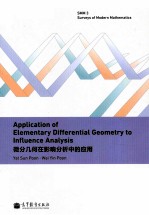

微分几何在影响分析中的应用PDF电子书下载
- 电子书积分:9 积分如何计算积分?
- 作 者:潘日新,潘伟贤编著
- 出 版 社:北京:高等教育出版社
- 出版年份:2012
- ISBN:7040357004
- 页数:174 页
Part Ⅰ Geometry 3
1 Preliminaries 3
1.1 Linear algebra 3
1.1.1 Vectors and matrices 3
1.1.2 Symmetric bilinear forms 5
1.1.3 Vector subspaces 6
1.1.4 Linear maps from Rn to Rn 7
1.1.5 A convention 9
1.2 Vector calculus 9
1.2.1 Vector-valued functions and differentials 9
1.2.2 Taylor expansion and extrema 11
1.2.3 Extrema and Lagrange multiplier theorem 12
2 Euclidean Geometry 15
2.1 Orthogonal transformations 15
2.2 Rigid motions 16
2.3 Translation of vector subspaces 18
2.4 Conformal transformations 20
2.5 Orthonormal basis 20
2.6 Orthogonal projections 23
2.7 Areas and volumes 25
3 Geometry of Graphs 29
3.1 Graphs in Euclidean spaces 29
3.2 Normal sections 31
3.3 Cross sections in high dimension 33
3.4 First fundamental forms 33
4 Curvatures 35
4.1 Normal curvatures 35
4.1.1 Definition 35
4.1.2 Principal curvatures and principal directions 37
4.2 Sectional curvatures 40
5 Transformations and Invariance 43
5.1 Change of coordinates 43
5.2 Non-linear conformal transformations 44
5.3 Invariant curvatures 46
Part Ⅱ Statistics 51
6 Discrete Random Variables and Related Concepts 51
6.1 Preliminaries 51
6.2 Discrete random variables 52
6.2.1 Discrete random variables and probability function 52
6.2.2 Relative frequency histogram 55
6.2.3 Cumulative distribution function 55
6.3 Population parameters and sample statistics 56
6.3.1 Population mean and expected value 56
6.3.2 Sample statistic 57
6.3.3 Sample mean 57
6.3.4 Sample and population variances 58
6.4 Mathematical expectations 60
6.5 Maximum likelihood estimation 61
6.6 Maximum likelihood estimation of the probability of a Bernoulli experiment 62
7 Continuous Random Variables and Related Concepts 65
7.1 Continuous random variables 65
7.2 Mathematical expectation for continuous random variables 66
7.3 Mean and variance and their sample estimates 66
7.4 Basic properties of expectations 67
7.5 Normal distribution 68
7.6 Maximum likelihood estimation for continuous variables 72
7.7 Maximum likelihood estimation for the parameters of normal distribution 73
7.8 Sampling distribution 74
8 Bivariate and Multivariate Distribution 77
8.1 Bivariate distribution for discrete random variables 77
8.1.1 Joint probability function 77
8.1.2 Marginal probability function 78
8.1.3 Conditional probability function 79
8.2 Bivariate distribution for continuous random variables 80
8.3 Mathematical expectations 80
8.3.1 Mathematical expectations for the functions of two random variables 80
8.4 Covariance and correlation 82
8.4.1 Sample covariance and correlation 82
8.4.2 Population covariance and correlation 84
8.4.3 Conditional expectations 85
8.5 Bivariate normal distribution 87
8.6 Independence 88
8.7 Multivariate distribution 89
9 Simple Linear Regression 93
9.1 The model 93
9.2 The least squares estimation 95
9.3 The maximum likelihood estimation of regression parameters 98
9.4 Residuals 99
9.5 Coefficient of determination 101
9.6 Weighted least squares estimates 103
10 Topics on Linear Regression Analysis 105
10.1 Multiple regression model 105
10.2 Estimation and interpretation 106
10.3 Influential observations and outliers 110
10.4 Leverage 111
10.5 Cook's distance 113
10.6 Deletion influence,joint influence and masking effect 114
107 Derivation of Cook's distances 116
10.7.1 Weighted least squares and Cook's distance 116
10.7.2 Cook's distance-deleting one data point 118
Part Ⅲ Local Influence Analysis 123
11 Basic Concepts 123
11.1 Introduction 123
11.2 Perturbation 125
11.3 Likelihood displacement and infuence graph 126
12 Measuring Local Influence 129
12.1 Individual influence 130
12.2 Derivation of normal curvature 131
12.3 Case-weight perturbation—an example 133
12.4 Roles of sectional curvature 135
12.5 Joint influence 138
13 Relations Among Various Measures 141
13.1 A bound on influence measures 141
13.2 Individual and overall joint influence 143
13.3 Individual andjoint influence measures 146
13.4 Competing eigenvalues 147
13.5 Conclusions 150
14 Conformal Modifications 153
14.1 Modification and invariance 153
14.2 Invariant measures 154
14.3 Benchmarks 155
14.4 Individual's contribution to joint influence—re-visited 157
Appendix A Rank of Hat Matrix 161
Appendix B Ricci Curvature 163
Appendix C Cook's Distance—Deleting Two Data Points 165
Bibliography 167
Index 171
- 《钒产业技术及应用》高峰,彭清静,华骏主编 2019
- 《现代水泥技术发展与应用论文集》天津水泥工业设计研究院有限公司编 2019
- 《英汉翻译理论的多维阐释及应用剖析》常瑞娟著 2019
- 《数据库技术与应用 Access 2010 微课版 第2版》刘卫国主编 2020
- 《区块链DAPP开发入门、代码实现、场景应用》李万胜著 2019
- 《虚拟流域环境理论技术研究与应用》冶运涛蒋云钟梁犁丽曹引等编著 2019
- 《影响葡萄和葡萄酒中酚类特征的因素分析》朱磊 2019
- 《当代翻译美学的理论诠释与应用解读》宁建庚著 2019
- 《第一性原理方法及应用》李青坤著 2019
- 《环境影响评价公众参与理论与实践研究》樊春燕主编 2019
- 《市政工程基础》杨岚编著 2009
- 《家畜百宝 猪、牛、羊、鸡的综合利用》山西省商业厅组织技术处编著 1959
- 《《道德经》200句》崇贤书院编著 2018
- 《高级英语阅读与听说教程》刘秀梅编著 2019
- 《计算机网络与通信基础》谢雨飞,田启川编著 2019
- 《海明威书信集:1917-1961 下》(美)海明威(Ernest Hemingway)著;潘小松译 2019
- 《看图自学吉他弹唱教程》陈飞编著 2019
- 《法语词汇认知联想记忆法》刘莲编著 2020
- 《培智学校义务教育实验教科书教师教学用书 生活适应 二年级 上》人民教育出版社,课程教材研究所,特殊教育课程教材研究中心编著 2019
- 《国家社科基金项目申报规范 技巧与案例 第3版 2020》文传浩,夏宇编著 2019
- 《全国高等中医药行业“十三五”创新教材 中医药学概论》翟华强 2019
- 《培智学校义务教育实验教科书教师教学用书 生活适应 二年级 上》人民教育出版社,课程教材研究所,特殊教育课程教材研究中心编著 2019
- 《指向核心素养 北京十一学校名师教学设计 英语 七年级 上 配人教版》周志英总主编 2019
- 《习近平总书记教育重要论述讲义》本书编写组 2020
- 《办好人民满意的教育 全国教育满意度调查报告》(中国)中国教育科学研究院 2019
- 《高等数学试题与详解》西安电子科技大学高等数学教学团队 2019
- 《北京生态环境保护》《北京环境保护丛书》编委会编著 2018
- 《教育学考研应试宝典》徐影主编 2019
- 《语文教育教学实践探索》陈德收 2018
- 《家庭音乐素养教育》刘畅 2018
